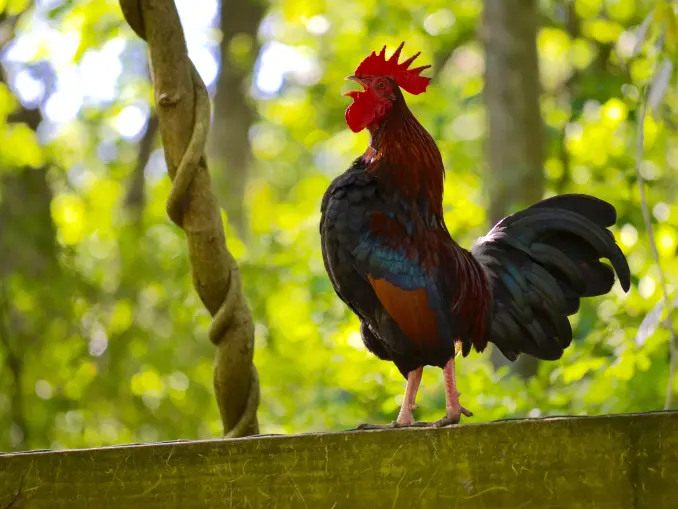Why Does the Rooster Crow in the Morning? An In-depth Look
Ever wondered why does the rooster crows in the morning? There’s more to it than just announcing the break of dawn. In fact, rooster crowing is a fascinating blend of biology, behavior, and cultural significance that’s captured people’s attention throughout history.
In this blog post, I’ll dive deep into rooster crowing, exploring the reasons behind this intriguing phenomenon and how it has influenced human culture.
The Morning Ritual: Rooster Crowing Explained
The distinctive sound of a rooster crowing in the morning is more than just a wake-up call; it’s a signal that a new day is beginning, and it’s time for the flock to get up and start their daily routine.
In a flock with more than one rooster, the head rooster will typically crow around 15 times a day, and if another rooster crows out of turn, they’ll receive a reminder of who’s the boss. Roosters have their own reasons for crowing, and it’s all about asserting their dominance and marking their territory.
Contrary to hens that lay eggs on a set schedule, the timing for the rooster crowing is rather unpredictable. Roosters begin to crow when they’re around four to five months old, and their first attempts at crowing are like a young man whose voice is cracking.
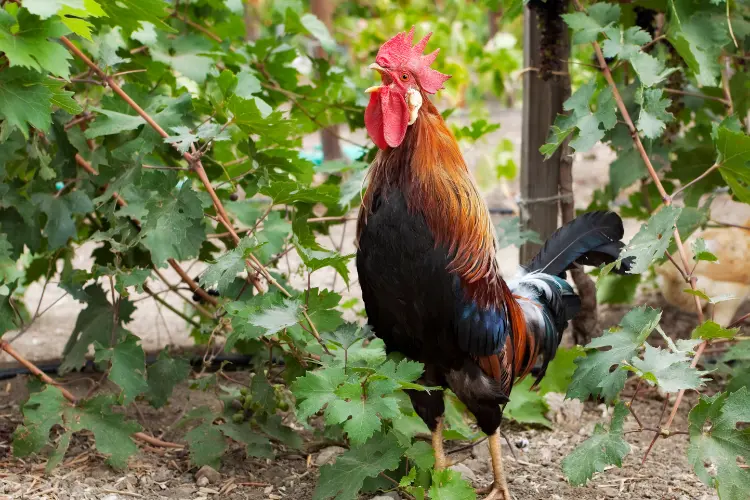
The Role of Circadian Rhythm
Our feathery friends have an internal clock called the circadian rhythm, which plays a significant role in their morning crowing. External stimuli like influence this internal clock:
- light
- the sound of other roosters crowing
- the rising and setting of the sun
- social interaction
As the sun rises, it triggers the rooster’s internal clock to crow. The fascinating thing about this is that roosters can crow anytime during the day, not just at dawn.
Signaling the Wake-Up Call
The morning crow serves a vital purpose for the flock, letting them know it’s time to wake up and start crowing to signal the start of the day and prepare them for their daily routine. In the early morning, roosters typically crow for this purpose.
Interestingly, just one rooster is usually enough to do the job, making them the natural alarm clocks not only for their fellow chickens but also for humans who may hear a “crow in the morning”.
Beyond acting as an alarm bell, roosters are instrumental in safeguarding their flock. Their crowing can help ward off potential threats and predators, ensuring their flock’s safety and well-being. In this sense, the rooster’s crow is more than just a sound; it’s a powerful tool that helps maintain the harmony and safety of the flock.
The Science Behind Rooster Crows
Vocal Cord Mechanics
Roosters don’t have vocal cords like humans, so how do they create those powerful crows? They produce sound by passing air through their syrinx, a tube-like structure in their throat.
The syrinx vibrates to create the crowing sound, allowing the rooster to produce crows reaching up to 130 decibels. To put that into perspective, a 130-decibel crow is as loud as a military jet taking off from an aircraft carrier or thunderclap.
These vocal cord mechanics allow roosters to produce such powerful crows while maintaining their ability to communicate with their flock and other roosters. It’s an impressive adaptation that has evolved to help roosters protect their territory and maintain their dominance within the flock.
Read also: Understanding Chicken Communication: Sounds Explained
Protecting Their Ears
Given the loudness of their crows, roosters must shield their ears from possible harm. Roosters have a built-in mechanism to protect their ears from their own crow. When they open their beaks fully, their external auditory canals close off completely, acting like earplugs.
Additionally, there’s a bit of material that covers the ear canal completely when the rooster tilts its head back to crow, offering further protection.
These adaptations help prevent the rooster from damaging its own hearing, ensuring they can continue effectively communicating with their flock and other roosters without causing harm to themselves.
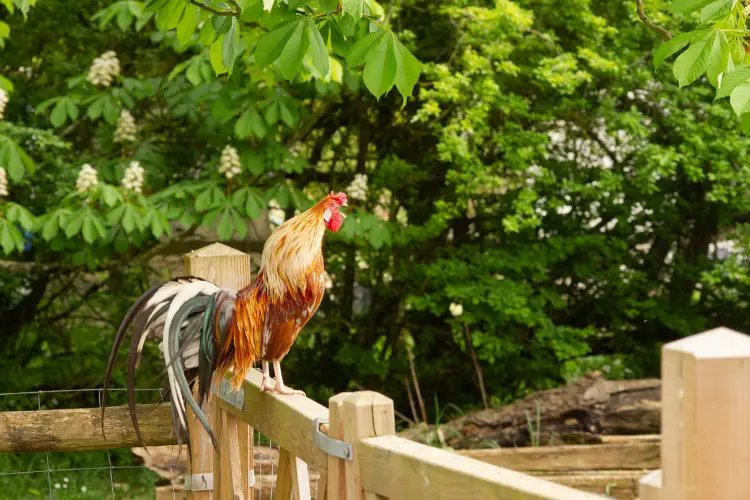
Rooster Crowing Throughout the Day
As we’ve discovered, roosters crow for various reasons throughout the day, not just in the morning. They use their crows to establish dominance within the flock and to warn of potential threats or predators in their environment.
What methods do roosters employ to assert their hierarchy within the flock through crowing, and how does it aid in defending their flock from threats? We will look more closely at these facets.
Establishing Dominance
Dominant roosters use their crowing to assert their position in the flock and communicate with other roosters.
The frequency of a rooster’s crowing is linked to its level of dominance, with dominant roosters tending to crow more often than subordinate ones to show their dominance and inform other roosters of their status.
Certain tones and patterns in a rooster’s crow can also signify dominance, with a dominant rooster having a louder voice to demonstrate its power.
When a dominant rooster crows, other roosters may respond by crowing as well, allowing them to communicate their own dominance within the flock and engage in a sort of “conversation” with their fellow roosters. This complex social interaction helps maintain the hierarchy within the flock and ensures each rooster knows its place.
Warning of Potential Threats
Roosters also use their crowing to:
- Alert the flock of potential dangers, such as predators or rival roosters.
- Give an alarm crow to warn the flock and protect them from harm if they spot a possible predator.
- Crow when cars drive past, perceiving them as a potential threat and asserting their territory.
Utilizing their crowing for communication and defense, roosters perform a key function in maintaining the security and welfare of their flock. This behavior showcases the intelligence and adaptability of these birds and their dedication to their role as protectors of their flock.
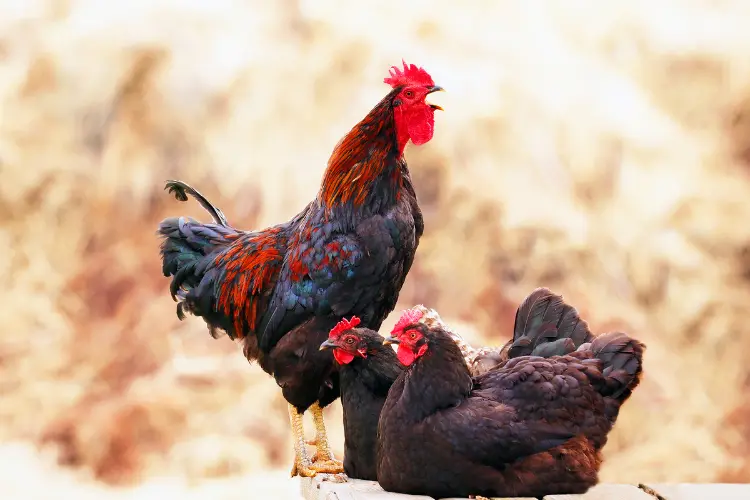
Managing Rooster Crowing
While the sound of a rooster crowing can be charming and even nostalgic for some, it can also be a source of annoyance for others, particularly in urban settings where noise levels are already high.
Luckily, there are several ways to manage rooster crowing.
Selecting Quieter Breeds
Some breeds of roosters are naturally quieter than others, making them more suitable for urban settings or for those who prefer a more peaceful environment.
Quieter rooster breeds tend to have a more subdued crow, which is deeper in tone but not as loud as larger breeds. Some breeds known for being quieter include Buff Orpingtons, Cochins, and Australorps.
By choosing a quieter breed, you can still enjoy the presence of a rooster without the disruption of loud crowing. It’s a win-win situation for both you and your feathery friends.
Providing a Calm Environment
Ensuring a calm and stress-free environment can also help reduce excessive crowing in roosters. Factors such as:
- overcrowding
- a small coop
- an imbalanced rooster-to-hen ratio
- fear of predators
- hunger
- frustration
can all contribute to stress in roosters and lead to excessive crowing. By addressing these issues and providing a peaceful environment, you can help reduce the triggers that may lead a rooster to crow excessively and make life more harmonious for both the rooster and the flock.
Read also: How Long Do Roosters Live? (Factors Affecting)
Implementing Rooster Collars
Another method for managing rooster crowing is the use of rooster collars. These devices are designed to tone down the volume of a rooster’s crow by lessening the force behind it, reducing the amount of air expelled from the rooster’s air sacs and lungs.
Rooster collars can be an effective way to lower the crowing volume, although they might not completely eliminate it. It’s a simple solution that can go a long way in making life more peaceful for everyone involved.
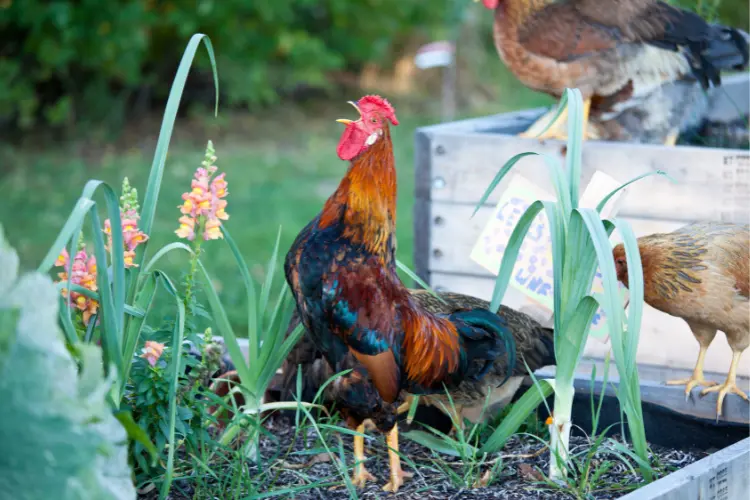
Rooster Crowing and Cultural Significance
Rooster crowing has played a significant role in various cultures throughout history, with these fascinating birds appearing in:
Folklore, symbolizing courage and vigilance
Art, representing fertility and protection
Architecture, serving as a symbol of our connection with these remarkable creatures
The rooster’s crow has captured the imagination of people worldwide and has become an enduring symbol.
Roosters in Folklore
Roosters have long been featured in folklore as symbols of courage, vigilance, and resurrection. In various cultures, the rooster is seen as a sacred animal closely linked to religious beliefs and worship. Its crowing is seen as a universal symbol of awakening and can represent new opportunities and possibilities.
Moreover, some cultures believe that the rooster crow wards off evil spirits and brings good luck, making it an important figure in many traditions worldwide, especially in those that also value chicken eggs. In fact, the moment the rooster crowed is often considered a symbol of a new beginning.
From the Rooster of Barcelos in Portuguese folklore to the Rooster’s Crow at Dawn in Asian traditions, these stories showcase the rich cultural significance of roosters and their crowing, highlighting the timeless connection between humans and these fascinating birds.
Symbolism in Art and Architecture
Roosters can also be found in art and architecture, representing themes such as fertility, protection, and the passage of time.
Artists have used various mediums, like paintings and sculptures, to portray the rooster’s crowing in their styles and interpretations, capturing the energy and symbolism associated with it.
In many cultures, the rooster is seen as a symbol of the dawn, as it crows to welcome in the new day.
From ancient art to contemporary pieces, the rooster has been a source of inspiration for artists and architects alike. Its enduring presence in our artistic and architectural heritage is a testament to the deep connection we share with these birds and the universal themes they represent.
So Why Does Rooster Crow in the Morning?
The crowing of the rooster in the morning is a fascinating natural phenomenon that serves multiple purposes, including marking territory, establishing social hierarchies, and signaling the start of a new day.
Studying the reasons behind why the rooster crows not only provides insights into the intricacies of animal behavior but also reminds us of the rich tapestry of the natural world that surrounds us.
If you’re intrigued by the world of animal behavior, especially when it comes to chicken raising, you can read more about this captivating topic on our website.

